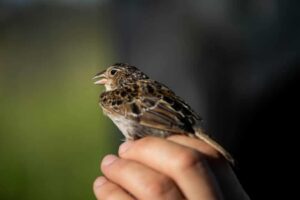
Scientists in Florida are hailing the landmark release this week of a tiny bird only 5in tall as an oversized success in their fight to save a critically endangered species.
Numbers of the Florida grasshopper sparrow, seen only in prairies in central regions of the state, dwindled so severely by 2015, mostly through habitat loss, that authorities took the decision to remove remaining breeding pairs into captivity. Their wager was that a controlled repopulation program would be more successful than leaving the birds to their own devices.
On Tuesday, their gamble was rewarded. Partners joined the Florida Fish and Wildlife Conservation Commission (FWC) to release into the wild the 1,000th bird bred under controlled conditions, adding to an increasingly stable population that researchers believe has turned the tide towards the species’ survival.
“The recovery and release program diverted the extinction of the Florida grasshopper sparrow,” said Adrienne Fitzwilliam, lead sparrow research scientist at the FWC’s fish and wildlife research institute.
“The fear was we might just be expediting their demise by bringing in proven breeders, so to see these birds making it in the wild, breeding with wild birds and other release birds, and their offspring going on to breed, has just been incredibly rewarding.
“It is a really good feeling. Looking back, we made the right choice, even though at the time there was a lot of anxiety about if we’re doing the right thing.”
Releases, which began in 2019, have taken place at three sites, with the newly freed birds monitored by patient teams of observers with binoculars and lawn chairs at two more. Birds are released in batches at about 40 days of age and, Fitzwilliam said, quickly set about setting up their “territory”.
“There’s a lot of sitting and waiting and watching because their nests are incredibly hard to find,” she said.
